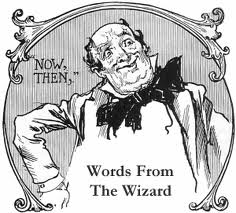 I’ll never forget the day after watching “The Wizard of Oz” for the umpteenth time that I finally realized that the Wizard character was a snake oil salesman. He could sell ice to Eskimos, and he indeed sold the Tim Man, the Cowardly Lion, and the Scarecrow exactly what they wanted in this final scene of the movie. It is exactly for this reason that I believe non-profit organizations need to hire the “Great and Powerful Oz” to sell donors on the idea of “community impact”.
I’ll never forget the day after watching “The Wizard of Oz” for the umpteenth time that I finally realized that the Wizard character was a snake oil salesman. He could sell ice to Eskimos, and he indeed sold the Tim Man, the Cowardly Lion, and the Scarecrow exactly what they wanted in this final scene of the movie. It is exactly for this reason that I believe non-profit organizations need to hire the “Great and Powerful Oz” to sell donors on the idea of “community impact”.
In the nonprofit community, everyone is going nuts over this idea. We need to “measure our impact” so we can demonstrate to stakeholders and donors that change is being made. Even I have gotten wrapped up in this Kansas tornado from time-to-time on this blog. Please don’t misunderstand. I firmly believe that every non-profit organization needs to create an impact agenda, measurement tools, and indicators. How else can they ever be sure that they are fulfilling their mission?
However, what I am starting to worry about is how carried away everyone seems to be getting with this idea. It gets bigger and bigger with every passing day. Here is the progression that I’ve seen recently with one national non-profit whose mission focuses on helping kids reach their full potential by offering after-school programming:
- It started a few decades ago with a program focused on helping kids do better on their homework. Impact conversations focused around the simple idea of “are they doing better with their homework assignments now compared to before they started participating in the homework assistance program?”
- It then morphed to High Yield Learning Activities (aka fun games with educational objectives like Math Bingo). Impact conversations evolved and started involving the idea of designing and implementing a pre- and post-test strategy to actually measure change and improvement.
- The conversation then quickly jumped to “collecting report cards” and claiming credit for kids who participate in these after-school program and who also seem to be maintaining or improving their grades in school.
- Today, the impact conversation is now focused on three HUGE “priority outcomes,” one of which is for their clients to “graduate from high school ready for college, trade school, military or employment”.
 Again . . . you will get no argument from me that an impact agenda and outcomes measurement are important. However, at what point does it get too big and impossible to measure? At what point are we selling snake oil to donors and supporters just like the Wizard of Oz did?
Again . . . you will get no argument from me that an impact agenda and outcomes measurement are important. However, at what point does it get too big and impossible to measure? At what point are we selling snake oil to donors and supporters just like the Wizard of Oz did?
There is NO WAY one non-profit organization can guarantee that even one of their clients will do better in school or even graduate all because that child walked into their facility and participated in their programs. When non-profits set an impact agenda that is wide enough to fly the space shuttle through it, then they set themselves up to be exposed. Just like the Wizard of Oz did in this YouTube clip.
The reality is that it takes one huge massive collaboration and partnership of many different non-profit organizations, schools, teachers, parents, and even taxpayers to all be pulling in the same direction if you want to achieve an impact like: “graduate X% of kids from high school who are ready for college, trade school, military or employment”.
There are so many variables that go into these HUGE impact agenda outcomes that I begin to wonder if funding one non-profit organization or one school district to do one small program with one small subset of kids makes any sense? Is it the right strategy? Or should non-profits and schools and parents and teachers be financially incented by donors to “collaborate”?
I am not smart enough to know what that looks like . . . however, I know when a dialog needs to be opened and I suspect it is this subject at this point in time.
 I applaud the United Way for tackling this issue because impact assessment is the right thing for non-profits to be doing and talking with donors about. However, who is going to step in and moderate this discussion because this path feels too big and too wide for the average size agency to walk down. Perhaps, it will be the United Way that finds its voice and leads everyone down the yellow brick road to a collaboration-based solution rather than focusing on individual programs.
I applaud the United Way for tackling this issue because impact assessment is the right thing for non-profits to be doing and talking with donors about. However, who is going to step in and moderate this discussion because this path feels too big and too wide for the average size agency to walk down. Perhaps, it will be the United Way that finds its voice and leads everyone down the yellow brick road to a collaboration-based solution rather than focusing on individual programs.
Is your nonprofit in the impact agenda and outcomes measurement business? What is working for you? What isn’t working? Are you honestly measuring things that demonstrate your success around mission? If so, how? Is there another road for the United Way to go down rather than funding odds and ends programs and claiming that this approach is helping close major gaps in our communities (e.g. academic failure, homelessness, joblessness, health care, etc)?
I’ve heard too many people in the last few months complain behind closed doors about this subject. It is time to bring the discussion into the open because we can learn from each other. Why not use the comment box below to start the conversation?
Here is to your health!
Erik Anderson
Founder & President, The Healthy Non-Profit LLC
www.thehealthynonprofit.com
erik@thehealthynonprofit.com
http://twitter.com/#!/eanderson847
http://www.facebook.com/eanderson847|
http://www.linkedin.com/in/erikanderson847

Your observation that the path is too big and too wide is astute. While impact assessment is necessary and can be valuable it is a struggle to determine the scope. All too often it can be too specific and narrow leaving the organization to start over with each campaign (we’ve accomplished that goal, now what?) or far too general and wide (everything we did made everything better). I believe the key is an consistently evolving process and willingness to reassess your assessment goals to not limit yourself. People and organizations grow and change, their processes should too.
Thanks, Amy. What you describe sounds very organic to me, which might be exactly what is warranted for this situation.
One reader who didn’t want to be identified shared with me via email that there is a book out there worth reading for those who kinda sorta agree with today’s blog post. The book info is as follows:
“HARD FACTS, Dangerous Half-Truths, and Total Nonsense; Profiting from Evidence Based Management” by Jeffrey Pfeffer and Robert Sutton. Here is the link on Amazon: http://www.amazon.com/Facts-Dangerous-Half-Truths-Total-Nonsense/dp/1591398622
Can there be a mix of long-term process and short-term program/project? An ebb and flow of service that a small nonprofit can offer?
I’ve seen a small tutoring program adapt month by month with changing services by having long-term tutoring service, short-term extra tutoring a month before graduation tests, and partnership with another program to capture kids who graduate or move away…
(I’m really liking the Oz Theme… I wonder if you can make something out of Wicked or The Wiz…)
I think, in fact, that a nonprofit that has a particularly common cause, like English/math tutoring, or urban farming (depending on how developed your city is in that), or helping juvenile offenders, should always have half their point-of-view on what their cohorts are doing and how to help them. Look at progress more on how the whole map is fairing.